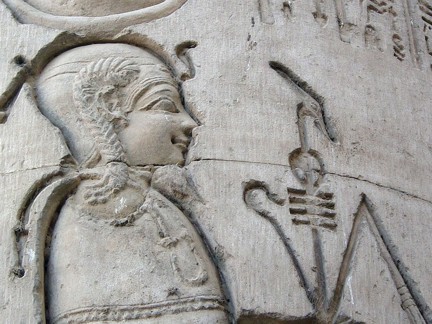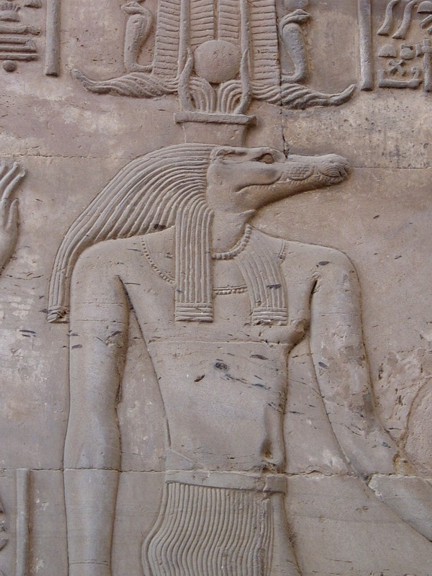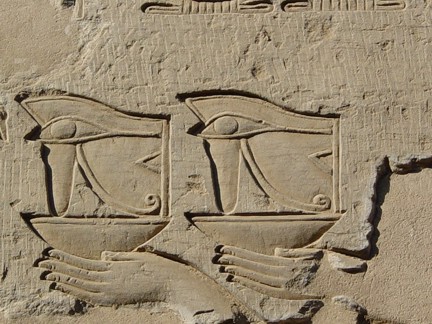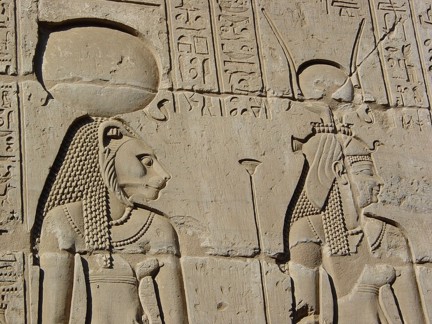Kom Ombo - Templo de Sobek y Haroeris
Kom Ombo (كوم أمبو) es una villa agrícola de Egipto de unos 60.000 habitantes, situada en la ribera oriental del río Nilo, a 40 kilómetros al norte de Asuán y a 165 kilómetros al sur de Luxor. Existe una numerosa población nubia procedente del sur, desplazados por la construcción del lago Nasser. El emplazamiento es conocido en la actualidad por su templo de época ptolemaica.
Situación: 24º 27' N 32º 57' E
Nombre egipcio: Nubt o Nubet. Nombre griego: Ombos. Nombre árabe: Kom Ombo
(No debe confundirse con la ciudad situada al norte de Naqada del mismo nombre: Ombos)
En su origen, fue un asentamiento llamado Nubt, del egipcio nbt, que significa "Ciudad de Oro". Por su situación, disfrutaba del control sobre la s rutas comerciales que se dirigían desde Nubia a través del Valle del Nilo, si bien su importancia creció con la construcción del templo en el siglo II a.C.
En la época griega, la ciudad estaba en la Tebaida, y era la capital del nomo Ombita (el nomo I del Alto Egipto), en la ribera oriental del Nilo. Ombos fue una fortificación militar bajo todas las dinastías egipcias, con los faraones, hasta los ptolomeos y los romanos, y disfrutaba de mucha fama por la grandiosidad de sus templos y su tradicional enemistad con los habitantes de Tentyris (Dendera).
Los templos
Subsisten dos templos, construidos con la piedra obtenida de las canteras vecinas. El más notorio de los dos se yergue sobre una colina arenosa y parece haber sido una especie de Panteón dado que, de acuerdo con las inscripciones conocidas, le había sido dedicado a Haroeris (Apolo) y las demás deidades del nomo Ombita por los soldados acuartelados allí.

El templo más pequeño, en el noroeste, estaba dedicado a Isis. Ambos poseen una arquitectura imponente y todavía conservan los brillantes colores con los que los adornaron sus constructores. Datan de la época ptolemaica, con la excepción de una entrada de piedra caliza, construida dentro de un muro de adobe. Constituía una parte de un templo construido por Tutmosis III en honor del dios, encarnado en cocodrilo, Sobek.
El templo de Kom Ombo, conocido también como templo de Sobek y Haroeris está en ruinas, pero resulta imponente, especialmente por su ubicación, que lo hace destacar al lado del Nilo. Fue excavado por Jacques de Morgan hacia 1893. Es un edificio inusual, completamente simétrico, con dos entradas, dos salas hipóstilas y dos santuarios. Esto se debe a que está dedicado a dos dioses: el lado izquierdo al dios halcón Haroeris (Horus el viejo o el grande) y el derecho a Sobek, divinidad local con cabeza de cocodrilo.
Lo comenzó a construir Ptolomeo VI en el siglo II a.C, siendo Kom Ombo capital de un nomo del Alto Egipto, y lo terminó Ptolomeo XII en el siglo I a.C. El emperador romano Augusto le añadió el pilono de la entrada hacia 30 a.C. En el local hubo un santuario más pequeño de la época de Tutmosis II encontrándose vestigios que datan de la Dinastía XVIII (1.550 a 1.063 a.C.)
Descripción
La planta, parecida a la del templo de Edfu, consta de un patio, dos salas (una de ellas, el pronaos) y tres vestíbulos (en vez de los dos de Edfu). Tiene, sin embargo, dos ambulacros misteriosos (sólo hay uno en Edfu), dispuestos en tres lados, alrededor de las cámaras.
En la fachada se disponen dos entradas, y a cada una de ellas corresponde un templo, paralelos entre sí. A pesar de esta bipartición arquitectónica estricta, las dos partes están unidas, muchos recintos son comunes e incluso en ambas se tributaban honores a las dos divinidades. el pilono está decorado con bajorrelieves del emperador romano Domiciano haciéndole ofrendas a la tríada de Sobek.
El patio está en ruinas, con los muros laterales y el pórtico destruidos. En las dos puertas que conducen al interior hay inscripciones y relieves con el nombre de Tiberio. A ambos lados de la doble puerta hay representaciones de Ptolomeo XII Neo Dionisio siendo purificado por Horus y Thot en presencia de Sobek (a la derecha) y de Haroeris (a la izquierda).
Desde él, dos puertas llevan a la primera sala hipóstila, el pronaos. En ella, hay grabadas escenas protagonizadas por Haroeris en el muro izquierdo y por Sobek en el derecho. Las columnas están talladas con lotos del Alto Egipto y papiros del delta del Nilo. En los muros, representaciones rituales relacionadas con la purificación del rey, la consagración del templo y las dos tríadas, con los nombres de Ptolomeo VIII Evergetes II, Cleopatra II y Ptolomeo XII Neo Dioniso.
En la segunda sala hipóstila, los muros muestran escenas de ofrendas con el nombre de Ptolomeo VI Filométor y Ptolomeo VIII Evergetes II. A continuación se sitúan tres vestíbulos.
En los santuarios se ven decoraciones semejantes a las de la fachada. En el corredor interno de la izquierda están representadas las divinidades del Nilo. Hay también figuras alegóricas de los distintos territorios agrícolas. En la parte norte hay cartuchos de Nerón y Vespasiano. Se ven representadas también todas las fases de la construcción del templo y las técnicas usadas, así como un grupo de instrumentos quirúrgicos, ya que el templo acogía enfermos. En el suelo, en el exterior del santuario, fueron grabados tableros de juegos entretenerse.
Delante del templo se encuentra el Mammisi, o templo del nacimiento de Horus, construido por Ptolomeo VIII Evergetes II, muy deteriorado por la humedad del Nilo. La capilla de Hathor está también al sur del templo y en ella hay varios cocodrilos momificados que provienen de una necrópolis de cocodrilos próxima al templo. En el 7º año de Domiciano fue decorada en honor de la diosa romana Afrodita.
Al norte del templo de Kom Ombo se encuentra otro templo, dedicado a Sobek, y construido por Caracalla. También hay unas ruinas coptas.
(2) Kom Ombo
le temple de kom ombo dedié a sobec, et horus le dieu a tete de faucon
Kom Ombo (كوم أمبو) (Coptic: ⲉⲙⲃⲱ Embo; Greek: Ὄμβοι Omboi, Ptol. iv. 5. § 73; Steph. B. s. v.; It. Anton. p. 165) or Ombos (Juv. xv. 35) or Latin: Ambo (Not. Imp. sect. 20) and Ombi is an agricultural town in Egypt famous for its temple. It was originally an Egyptian city called Nubt, meaning City of Gold (not to be confused with the city north of Naqada that was also called Nubt/Ombos). It became a Greek settlement during the Greco-Roman Period. The town's location on the Nile 50 km north of Aswan (Syene) gave it some control over trade routes from Nubia to the Nile Valley, but its main rise to prominence came with the erection of the temple in the 2nd century BC.
In antiquity the city was in the Thebaid, the capital of the Nomos Ombites, upon the east bank of the Nile; latitude 24° 6′north. Ombos was a garrison town under every dynasty of Egypt, Pharaonic, Macedonian, and Roman, and was celebrated for the magnificence of its temples and its hereditary feud with the people of Tentyra.
Ombos was the first city below Syene at which any remarkable remains of antiquity occur. The Nile, indeed, at this portion of its course, was ill-suited to a dense population in antiquity. It runs between steep and narrow banks of sandstone, and deposits but little of its fertilizing slime upon the dreary and barren shores. There are two temples at Ombos, constructed of the stone obtained from the neighboring quarries of Hadjar-selseleh. The more magnificent of two stands upon the top of a sandy hill, and appears to have been a species of Pantheon, since, according to extant inscriptions, it was dedicated to Aroeres (Apollo) and the other deities of the Ombite nome by the soldiers quartered there. The smaller temple to the northwest was sacred to Isis. Both, indeed, are of an imposing architecture, and still retain the brilliant colors with which their builders adorned them. They are, however, of the Ptolemaic age, with the exception of a doorway of sandstone, built into a wall of brick. This was part of a temple built by Tuthmosis III in honor of the crocodile-headed god Sobek. The monarch is represented on tress, the door-jambs, holding the measuring reed and chisel, the emblems of construction, and in the act of dedicating the temple. The Ptolemaic portions of the larger temple present an exception to an almost universal rule in Egyptian architecture. It has no propylon or dromos in front of it, and the portico has an uneven number of columns, in all fifteen, arranged in a triple row. Of these columns thirteen are still erect. As there are two principal entrances, the temple would seem to be two united in one, strengthening the supposition that it was the Pantheon of the Ombite nome. On a cornice above the doorway of one of the adyta is a Greek inscription, recording the erection, or perhaps the restoration of the sekos by Ptolemy VI Philometor and his sister-wife Cleopatra II, 180-145 BC. The hill on which the Ombite temples stand has been considerably excavated at its base by the river, which here strongly inclines to the Arabian bank.
The crocodile was held in especial honor by the people of Ombos; and in the adjacent catacombs are occasionally found mummies of the sacred animal. Juvenal, in his 15th satire, has given a lively description of a fight, of which he was an eye-witness, between the Ombitae and the inhabitants of Tentyra, who were hunters of the crocodile. On this occasion the men of Ombos had the worst of it; and one of their number, having stumbled in his flight, was caught and eaten by the Tentyrites. The satirist, however, has represented Ombos as nearer to Tentyra than it actually is, these towns, in fact, being nearly 100 miles from each other. The Roman coins of the Ombite nome exhibit the crocodile and the effigy of the crocodile-headed god Sobek.
In Kom Ombo there is a rare engraved image of Cleopatra VII in the walls of the main temple and also the engraving of what is though to be the first representation of medical instruments for performing surgery, including scalpels, curettes, forceps, dilator, scissors and medicine bottles dating from the days of the Roman Egypt.
At this site there is another Nilometer used to measure the level of the river waters.
On the opposite side of the Nile was a suburb of Ombos, called Contra-Ombos.
The city was a bishopric before the Muslim conquest, and Ombos was a titular see of the Roman Catholic Church, Ombi; which has been vacant since 1966. Karol Wojtyła (the future Pope John Paul II) was titular bishop of Ombi from 1958 until 1963, when he was appointed Archbishop of Kraków.
This article incorporates text from the public domain Dictionary of Greek and Roman Geography by William Smith (1857).
Texto: Wikipedia



0 comentarios